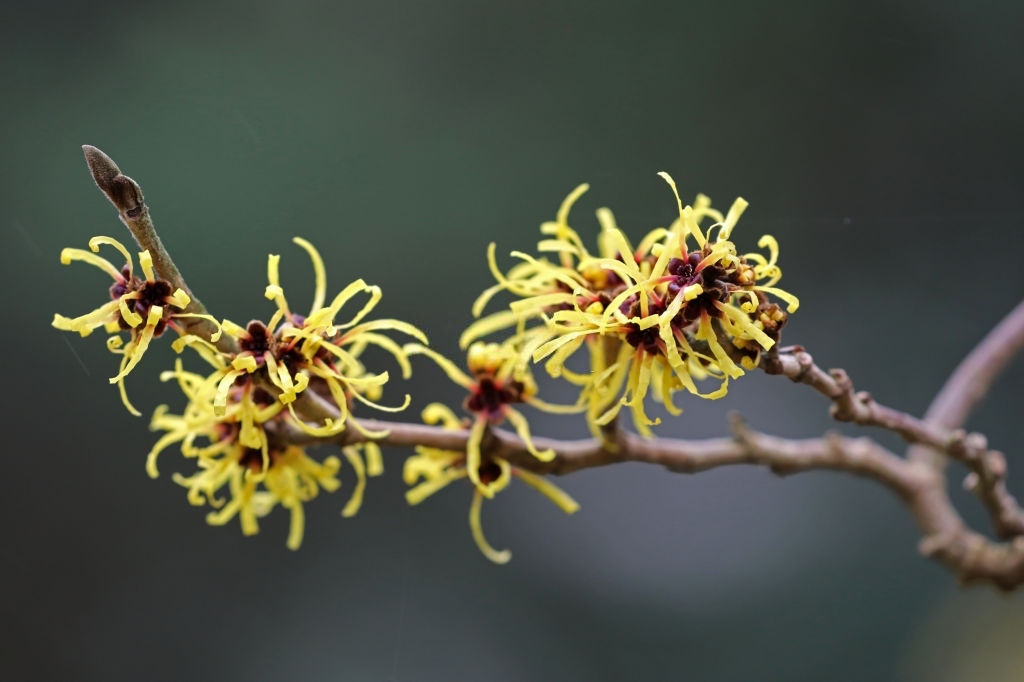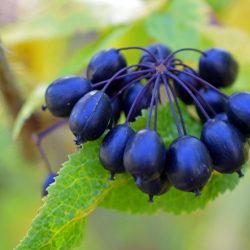If the etymology does not tell us much about witch hazel, on the other hand the French and English synonyms tell us more: “ Witch-hazel “ → Le noisetier de sorcière. In fact, this endemic shrub in North America played the same role there, or nearly so, as the hazel tree in Europe. Dowsing rods were made from its branches , while Native American wizards did not hesitate to have recourse to it to treat various ailments : hemorrhages, excessive periods, skin and eye inflammation, tumors, etc.
A little history
In 1736, the famous botanist John Bartram (1699-1777), who traveled the United States to collect plants, met witch hazel. Peter Collinson (1694-1768), who maintained a correspondence with Bartram , was the one who brought witch hazel back to Europe in the middle of the 18th century. But it was not really until the 19th century that the therapeutic properties that we know of it will be established , in particular thanks to the work of the French doctor Georges Dujardin-Beaumetz (1833-1895) who will introduce witch hazel into the classic medication of venous disorders . We also owe to other researchers the demonstration of the anti-infectious properties of this shrub on genitourinary disorders including gonorrhea. Moreover, hydroalcoholic and aqueous extracts gave good results on Gram + and Gram – germs, in particular by the action of an ester, ethyl gallate .
What are the main pharmacological properties of witch hazel leaves?
Astringent properties:
In vivo , witch hazel indeed inhibits the activity of α-glucosidase and elastase in human leukocytes; connective tissue degradation enzymes. By protecting the latter, witch hazel helps maintain the integrity of the vessel wall . Its astringent tissue tightening activity , its antihemorrhagic and hemostatic properties (promoting blood coagulation) are related to its concentration in tannins and flavonoids. It explains the use of the plant in the treatment of circulation and microcirculation disorders .
The astringent action of tannins on the intestinal mucosa can give it antidiarrhoeal properties by slowing down intestinal peristalsis.
-
Vasoconstrictor and venotonic:
Witch hazel is in particular a plant with recognized therapeutic virtues, both orally and for local application. The galenic form seems ultimately to constitute an important efficacy criterion, as confirmed in 1972 by an in vivo analysis of the venotonic and vasoconstrictive properties of witch hazel.
This study also tested several types of preparations made from witch hazel leaves. Not only has the venotonic action of these preparations been characterized, but the fluid extract of witch hazel has been shown to be the most active galenic form from a vasoconstrictor point of view, medicinal tinctures and alcoholic atomisats being much less active. It has been shown that the vasoconstrictor action is mainly due to the proanthocyanides found in the leaves.
-
Vitamin P activity:
It is the tannins and flavonoids that contribute to this activity. The result of this action leads in particular to an increase in the resistance of the blood capillaries and protection of the vascular endothelium.
Anti-inflammatory, antioxidant and cytoprotective properties:
The proanthocyanidins (catechin and epicatechin) of witch hazel indeed exert an anti-edematous action by inhibiting the activity of 5-lipoxygenase on the conversion of arachidonic acid into leukotrienes. This anti-inflammatory activity was therefore confirmed in vivo . Witch hazel proanthocyanidols effectively inhibit the elastase of human polymorphonuclear cells.
A topical containing a witch hazel distillate applied topically to the skin suppresses the UV-induced erythema within 24 hours, thus confirming the local anti-inflammatory activity of the plant. This protection against damage caused by UV was thus confirmed in a study carried out on 30 healthy volunteers, showing the significant anti-erythematous action of an after-sun lotion containing 10% witch hazel.
In addition to inhibiting tumor necrosis factor α (TNFα) and reducing inflammation, witch hazel also has an effective antioxidant action and protects skin fibroblasts from damage induced by oxidizing agents such as hydroxyl radical, superoxide anion. and singlet oxygen. The powerful antioxidant activity of witch hazel has notably been demonstrated in several other studies.
Hamamelis virginiana witch hazel also exhibits specific cytotoxic activity against colon cancer cells , which may explain the use of the plant to inhibit the growth of colon cancer.
Anti-infectious properties:
-
Bacteriostatic and molluscicide:
The hydroalcoholic extract of witch hazel exerts, among other things , bacteriostatic activity , mainly Gram (-) bacteria. More recently, an action of certain hamamelitanin derivatives on pathogenic biofilms with potentiation of vancomycin has been shown in the treatment of infections resistant to Staphylococcus aureus .
Witch hazel increases the sensitivity to antibiotics of Staphylococcus aureus biofilms , by inhibiting the detection of quorum ( quorum sensing ), that is to say by disrupting the regulatory mechanisms responsible for controlling the bacterial density within the pathogenic biofilm.
-
Antiviral:
Witch hazel has an antiviral action against the herpes virus (HSV-1). A 2014 study showed that its tannins are active against influenza A virus and human papillomavirus.
Are there any precautions for use with Witch Hazel?
Contraindications:
- In the absence of sufficient data, the EMA does not recommend taking witch hazel during pregnancy or breastfeeding. The European agency issues the same recommendation in children under 12 years of age, as well as in adolescents under 18 years of age in the event of local anorectal use in the hemorrhoidal indication.
Precautions for use:
- It is advisable to consult a doctor in case of anorectal bleeding, before starting treatment with witch hazel.
- Rare cases of hepatotoxicity by tannins.
How to take Witch Hazel and in what dosage?
Dry form:
- As a food supplement, in the form of standardized fresh plant extract, dry extract, powder, in capsules .
Liquid form:
- Standardized fluid extract of fresh plant : 5 to 10 ml per day in a glass of water
- Mother tincture , hydroalcoholic extract : 50 drops 1 to 2 times a day in a glass of water
- Infusion : 5 to 10 g of dry plant / L for 5 to 10 minutes, 1 to 2 cups per day.
In local application:
- The alcohol-free liquid forms can also be used for local skin application or in mouthwashes. Witch hazel extracts can be used in the composition of ointments (especially in the form of drugs), creams, lotions or magistral preparations for local use.
Witch hazel in masterly preparation of standardized extracts in liquid form (EPS)
In association with the red vine :
In venocapillary insufficiency and / or fragility, rosacea, repair and scarring of connective tissue after a vascular breach.
In combination with horsetail :
For ligament injuries ( ankle sprain ), muscles, hematomas or epistaxis.
In association with horse chestnut :
Against hemorrhoidal crises and hemorrhoidal bleeding.
In association with walnut:
In the fight against chronic inflammatory bowel disease (IBD) in flare with bloody diarrhea.
Medical bibliographic sources and clinical trials :
- Erdelmeier C.A. et al., Antiviral and antiphlogistic activities of Hamamelis Virginiana bark, Planta Med., 1997
- Hartisch C. et al., Dual inhibitory actiivities of tannins from Hamamelis virginiana and related polyphenols on 5-lipoxygenase and lyso-PAF ; acetyl-CoA acetyltranslyso-PAF : acetyl-CoA acetyltransferase, Planta Med., 1997
- European Medicines Agency, Community herbal monograph on Hamamelis virginiana L., cortex, 2011
- Korting H.C. et al., Anti-inflammatory activity of hamamelis distillate applied topically to the skin, Eur J Clin Pharmacol, 1993
- Brackman G. et al. The Quorum Sensing Inhibitor Hamamelitannin Increases Antibiotic Susceptibility of Staphylococcus aureus Biofilms by Affecting Peptidiglycan Biosynthesis and eDNA Release; Sci Rep., 2016
- Vermote A. et al. Synthesis and biological evaluation of novel hamamelitannin analyse logues as potentiators for vancomycin in the treatment of biofilm …; Bioorg Med Chem., 2016
- Vermote A. et al., Novel hamamelitannin analogues for the treatment of biofilm related MRSA infections. A scaffold hopping approach, Eur J Med Chem., 2017
- Hugues-Formella B.J. et al., anti-inflammatory Effect of Hamamelis Lotion in a UVB Erythema Test, Dermatology, 1998
- Masaki H. et al., Active-oxygen scavenging activity of plant extracts, Biol Pharm Bull., 1995
- Pereira Da Silva A. et al., Antioxidants in medicinal plant exracts. A reseach study of the antioxidant capacity of Crataegus, Hamamelis and Hydrastis, Phytotherapy Research, 2000
- Theisen L.L. et al., Tannins from Hamamelis virginiana bark extract ; characterization and improvement of the antiviral efficacy against influenza A virus and human papillomavirus, PLoS One, 2014







